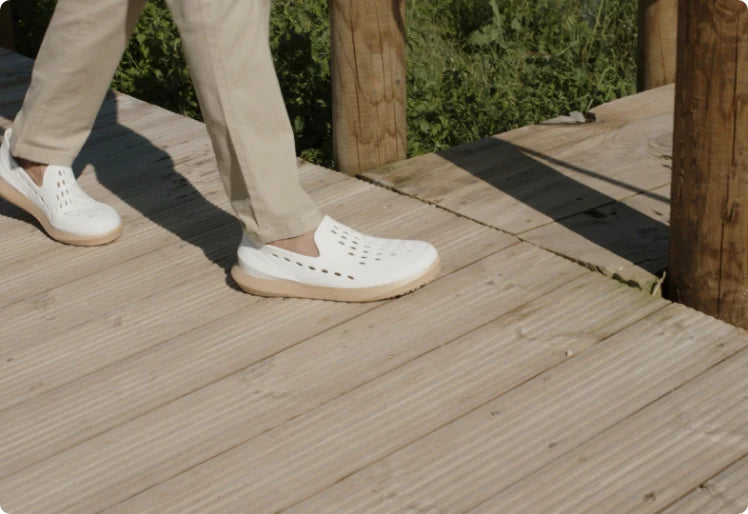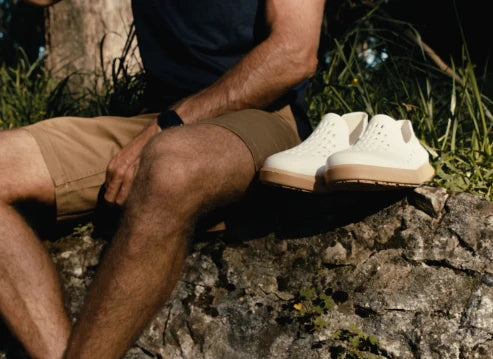Introduction
Shoe soles are essential components of footwear, playing a crucial role in ensuring comfort, support, and overall performance. The material used for shoe soles can have a significant impact on these factors.
One such material that has gained popularity in the footwear industry is EVA (Ethylene Vinyl Acetate). EVA is a type of foam known for its unique properties, making it an excellent choice for shoe soles:
- Lightweight
- Flexible
- Durable
In fact, some of the best-selling footwear collections in the market today feature EVA soles prominently. This comes as no surprise given the numerous benefits that shoe soles with EVA material offer. From enhancing comfort to offering superior shock absorption, EVA soles have become a preferred option for many footwear designs.
In this article, we will further explore the various advantages of shoe soles with EVA material, shedding light on why they have become a staple in the industry.
1. Lightweight and Flexible
EVA Material: Enhancing Comfort and Agility
EVA material is well-known for being lightweight, which makes it a great choice for designing comfortable and agile footwear. Here's why:
- Comfort: The lightness of EVA reduces the overall weight of shoes, making them more comfortable to wear for long periods without feeling tired.
- Agility: Light shoes enable faster movements, which is especially beneficial for athletes and people who are always on the go.
Supporting Natural Foot Movement
Another advantage of EVA material is its flexibility. Here's how it benefits your feet:
- Support: EVA soles can easily bend along with the natural movement of your foot, providing support where you need it.
- Flexibility: This pliable base helps maintain proper foot mechanics, reducing the risk of injuries and improving overall foot health.
Examples of Popular Shoe Models
Many popular shoe models use lightweight and flexible EVA soles to deliver exceptional performance and comfort:
- Nike Free RN: This model stands out for its incredibly lightweight design. It features an EVA midsole that offers excellent flexibility and support.
- Adidas Ultraboost: With EVA components in its sole structure, this shoe provides outstanding cushioning and adaptability.
- ASICS Gel-Nimbus: By incorporating EVA materials, this shoe delivers a combination of comfort, flexibility, and durability.
These examples showcase how EVA material can elevate both performance and comfort across different types of footwear.
To enhance your experience further, it's also important to consider other aspects when selecting shoes. For instance, shipping policy should be taken into account.
2. Cushioning and Shock Absorption
EVA Material is well-known for its great cushioning properties. This quality helps protect the feet from impact injuries by providing a soft, yet supportive, base for the foot.
Key Benefits:
- Cushioning Properties: EVA soles can compress and then bounce back to their original shape. This reduces the force of impact, making it easier on your feet.
- Shock Absorption: Shoes with EVA soles are excellent at absorbing shock, which reduces strain on the joints. This is especially important for activities like running or jumping that involve a lot of impact.
The importance of effective shock absorption is clear when it comes to sports performance. Many athletic shoes use EVA material to improve comfort and enhance performance. Here are some examples:
- Running Shoes: Brands like Nike and Asics use EVA in their midsoles to give runners a smooth, cushioned experience.
- Basketball Shoes: Models such as Adidas Harden Vol. 4 use EVA for maximum shock absorption during intense movements.
Why It Matters:
- Reduces risk of injuries
- Enhances comfort during prolonged use
- Improves overall athletic performance
EVA soles offer a combination of cushioning and shock absorption that is hard to find elsewhere, making them an excellent choice for both everyday and sports footwear.
3. Durability and Longevity
EVA Material is known for its ability to withstand damage and improve the durability of shoe soles. This means that shoes with EVA soles can handle a lot of wear and tear, making them a reliable choice for many.
Benefits of EVA Material for Shoe Soles
- Long-lasting Quality: EVA's natural properties significantly contribute to the lifespan of shoes. Footwear with EVA soles maintains its shape and performance over long periods.
- Extended Lifespan: The long-lasting quality of EVA helps shoes last longer overall. This makes it a cost-effective option for consumers looking for value.
Examples and Studies
- Popular Models: Many brands like Nike and Adidas have used EVA soles in their designs, especially in running and athletic shoes known for being durable.
- Research Insights: Studies have found that shoes with EVA soles can handle more compression cycles compared to materials like rubber or PU foam, leading to better long-term performance.
Shoes with EVA soles not only provide comfort but also have a long lifespan, making them a wise investment for anyone looking for durable footwear.
4. Moisture Resistance and Quick Drying
EVA Material is known for being resistant to moisture, which makes it a great choice for shoe soles. EVA (Ethylene Vinyl Acetate) is a type of foam that has cells that are closed off, so it doesn't soak up water. This quality helps to keep shoes dry, even when they're exposed to wet conditions.
Benefits of Quick-Drying Properties:
- Prevents Bacterial Growth: When shoes stay wet for a long time, it creates a breeding ground for bacteria and fungus. This can cause unpleasant odors and potentially lead to foot infections. The quick-drying nature of EVA soles helps to prevent these issues by getting rid of moisture quickly.
- Maintains Foot Hygiene: By keeping your feet dry, EVA soles contribute to better overall foot hygiene. This is especially beneficial for people who wear shoes for long periods of time.
Situations Where Moisture Resistance and Quick Drying Shine:
- Outdoor Activities: Whether you're hiking, trekking, or participating in any kind of adventure sport, there's always a chance of encountering water from streams or unexpected rain showers. Shoes with EVA soles are advantageous in these situations because they dry fast and provide ongoing comfort.
- Sporting Events: Athletes, particularly runners and soccer players, often have to deal with wet conditions either from their own sweat or damp playing surfaces. EVA soles help to keep their feet dry, allowing them to focus on their performance without any discomfort.
- Everyday Use in Humid Climates: If you live in a place with high humidity levels, having moisture-resistant footwear is important to avoid that sticky feeling that comes from dampness. It also helps prevent any potential health issues that can arise from prolonged exposure to moisture.
Key Takeaway: The moisture-resistant and quick-drying properties of EVA material significantly enhance footwear performance, making it ideal for various activities and environments.
5. Non-Toxicity and Eco-Friendliness
EVA material is well-known for being non-toxic, making it a safe choice for footwear. Unlike some other materials used in shoe manufacturing, EVA doesn't have any harmful chemicals that can irritate the skin or cause other negative effects. This is especially beneficial for people with sensitive skin or allergies.
Key Benefits:
- Non-Toxic: EVA doesn't contain harmful substances like phthalates and heavy metals, making it safer for long-term contact with the skin.
- Health Impact: By avoiding toxic chemicals, EVA material helps reduce the risk of allergic reactions and other health issues, ensuring a more comfortable wearing experience.
In addition to being non-toxic, EVA material is also eco-friendly. One of its standout features is its ability to be recycled. This means that shoes with EVA soles can be broken down and repurposed at the end of their life cycle, which helps reduce waste and preserve natural resources.
Eco-Friendly Characteristics:
- Recyclable: EVA soles can be recycled into new products, minimizing environmental impact and promoting sustainability.
- Reduced Waste: By choosing recyclable materials like EVA, manufacturers contribute to decreasing the amount of waste that goes into landfills.
These qualities make EVA material the top choice for environmentally conscious consumers who want sustainable footwear options without compromising on performance or comfort.
Comparison to Other Shoe Sole Materials
When evaluating shoe soles, EVA material often stands out. Comparing it with other common materials like rubber and PU foam reveals several distinct advantages.
Rubber
Rubber is traditionally used in shoe soles due to its durability and excellent grip. However, it tends to be heavier and less flexible compared to EVA.
- Weight: Rubber is significantly heavier, which can add unnecessary bulk to the shoes.
- Flexibility: While durable, rubber lacks the same level of flexibility as EVA, potentially hindering natural foot movement.
- Cushioning: Rubber offers decent cushioning but doesn't match the superior shock absorption properties of EVA.
PU Foam
PU foam is another material commonly found in shoe soles due to its cushioning abilities. However, it still falls short in a few areas when compared to EVA.
- Weight: PU foam is heavier than EVA, which can affect the overall comfort and agility of the footwear.
- Durability: Although durable, PU foam can break down faster under continuous stress compared to the resilient nature of EVA.
- Moisture Resistance: Unlike EVA, PU foam is not inherently moisture-resistant and may absorb water over time.
Superior Benefits of EVA Material
The previous sections have highlighted several key benefits of EVA material:
- Lightweight and Flexible: Enhances comfort and supports natural foot movement, making it ideal for everyday wear and athletic activities.
- Cushioning and Shock Absorption: Provides excellent protection against impact injuries, reducing strain on joints during high-impact activities.
- Durability and Longevity: The resilient nature ensures a longer lifespan for footwear products.
- Moisture Resistance: Quick-drying properties help in maintaining foot hygiene by preventing bacterial growth.
Combining these attributes makes EVA a superior choice for shoe soles compared to rubber and PU foam.
Conclusion
Prioritizing Footwear with EVA Soles
Given the numerous benefits of shoe soles with EVA material, it's clear why they should be a top choice for anyone looking to enhance their footwear experience. The versatile advantages include:
- Lightweight and Flexible: Enhances comfort and allows for natural foot movement.
- Cushioning and Shock Absorption: Protects feet from impact injuries, reducing strain on joints.
- Durability and Longevity: Ensures a longer lifespan for your footwear.
- Moisture Resistance and Quick Drying: Keeps feet dry and hygienic, preventing bacterial growth.
- Non-Toxicity and Eco-Friendliness: Safe for wearers and better for the environment.
Trying out a pair of shoes with EVA soles can provide firsthand experience of these benefits. Whether you are an athlete seeking better performance or someone who values comfort and durability in everyday wear, EVA soles offer an ideal solution.




